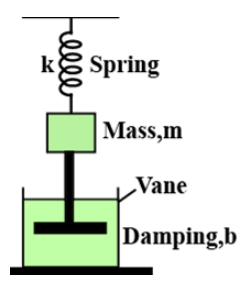
For the damped oscillator shown in Fig, the mass of the block is

Calculate:
(a) The period of oscillation,
(b) Time period for its amplitude of vibrations to drop to half of its initial value
(c) The time for the mechanical energy to drop to half initial value.

Answer
425.7k+ views
Hint: The amplitude of oscillations steadily decreases over time as a result of radiation from an oscillating mechanism and friction in the system. An oscillator's amplitude (or energy) is reduced by damping, and the oscillations are said to be damped.
Complete step by step answer:
Damping is a force acting inside or on an oscillatory organ that reduces or prevents it from oscillating. Damping is created in physical systems by processes that dissipate the energy contained in the oscillation. Viscous drag in mechanical devices, resistance in electronic oscillators, and light absorption and scattering in optical oscillators are all examples. Other oscillating mechanisms, such as those used in biological systems and bicycles, may benefit from damping that is not dependent on energy loss.
(a)
(b) If
(c) If T’ is the time, when mechanical energy drops to half its mechanical energy
Note: The period and frequency of a device with a small amount of damping are approximately the same as with basic harmonic motion, but the amplitude steadily decreases. Since the non-conservative damping force extracts energy from the device, usually in the form of thermal energy, this happens.
Complete step by step answer:
Damping is a force acting inside or on an oscillatory organ that reduces or prevents it from oscillating. Damping is created in physical systems by processes that dissipate the energy contained in the oscillation. Viscous drag in mechanical devices, resistance in electronic oscillators, and light absorption and scattering in optical oscillators are all examples. Other oscillating mechanisms, such as those used in biological systems and bicycles, may benefit from damping that is not dependent on energy loss.
(a)
(b) If
(c) If T’ is the time, when mechanical energy drops to half its mechanical energy
Note: The period and frequency of a device with a small amount of damping are approximately the same as with basic harmonic motion, but the amplitude steadily decreases. Since the non-conservative damping force extracts energy from the device, usually in the form of thermal energy, this happens.
Latest Vedantu courses for you
Grade 10 | MAHARASHTRABOARD | SCHOOL | English
Vedantu 10 Maharashtra Pro Lite (2025-26)
School Full course for MAHARASHTRABOARD students
₹33,300 per year
Recently Updated Pages
Master Class 11 Economics: Engaging Questions & Answers for Success

Master Class 11 Business Studies: Engaging Questions & Answers for Success

Master Class 11 Accountancy: Engaging Questions & Answers for Success

Master Class 11 English: Engaging Questions & Answers for Success

Master Class 11 Computer Science: Engaging Questions & Answers for Success

Master Class 11 Maths: Engaging Questions & Answers for Success

Trending doubts
State and prove Bernoullis theorem class 11 physics CBSE

1 ton equals to A 100 kg B 1000 kg C 10 kg D 10000 class 11 physics CBSE

State the laws of reflection of light

One Metric ton is equal to kg A 10000 B 1000 C 100 class 11 physics CBSE

1 Quintal is equal to a 110 kg b 10 kg c 100kg d 1000 class 11 physics CBSE

Difference Between Prokaryotic Cells and Eukaryotic Cells




